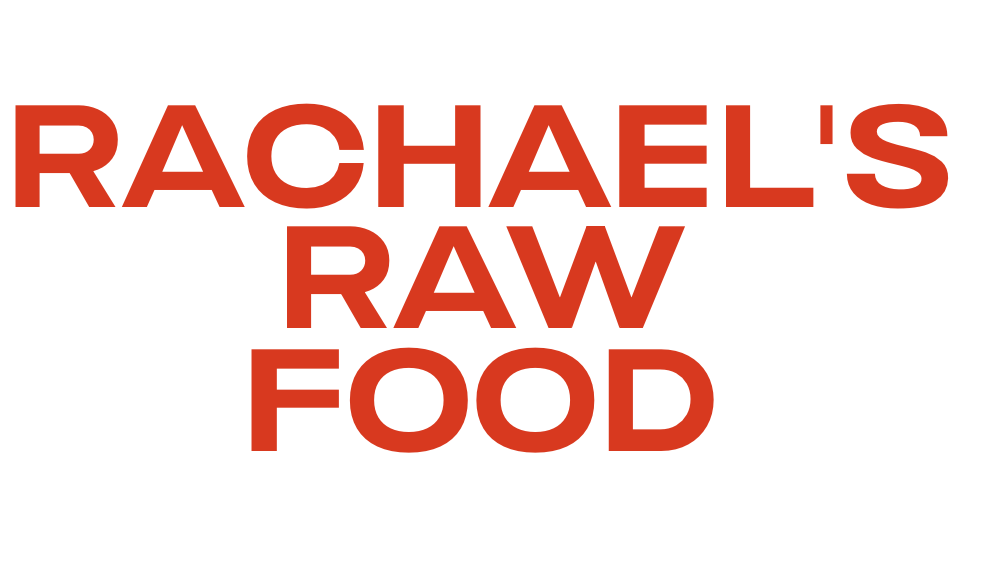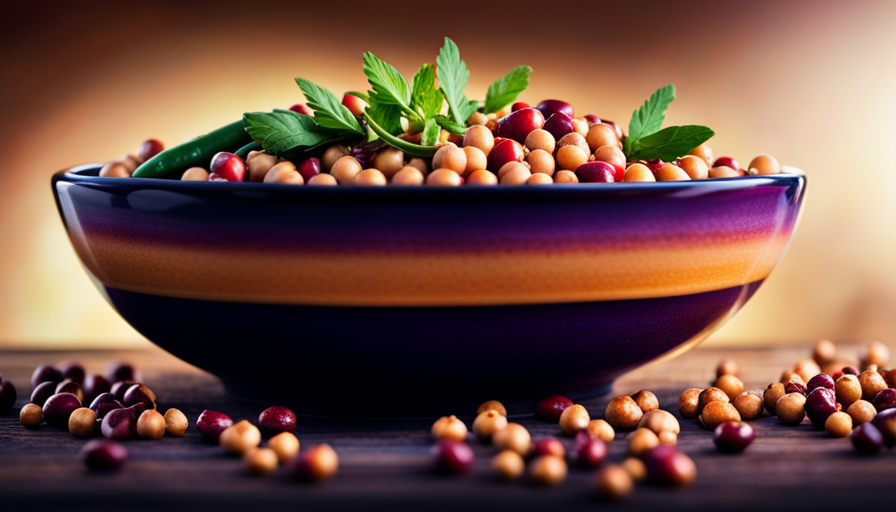Are you ready to enhance your raw food diet? Get ready to explore the advantages of legumes! Incorporating legumes into your raw food recipes can greatly enhance your health and overall wellness. These tiny yet powerful ingredients are not just delicious but also packed with essential nutrients that will help boost your body’s well-being.
Now, you might be thinking, ‘How do I even eat legumes in their raw form?’ Don’t worry, I’ve got you covered. In this article, I will guide you through the ins and outs of including legumes in your raw food diet.
From soaking and sprouting techniques to creative recipe ideas, you’ll discover the best ways to enjoy legumes in their raw, nutritious state.
So, get ready to explore the benefits, nutritional profiles, and storage tips for legumes.
Whether you’re a salad lover, a soup enthusiast, or have a sweet tooth, there’s a legume-based recipe waiting for you.
Let’s dive in and unlock the incredible potential of legumes in your raw food journey!
Key Takeaways
- Sprouting legumes improves digestibility and increases nutritional value.
- Soaking legumes before consumption reduces cooking time and improves digestibility.
- Legumes such as chickpeas, lentils, and black beans are rich in protein, fiber, iron, and folate.
- Legume-based spreads like hummus and black bean dip are packed with protein, fiber, vitamins, and minerals.
Understand the Benefits of Incorporating Legumes into a Raw Food Diet
You’ll love the amazing benefits of adding legumes to your raw food diet! Legumes, such as lentils, chickpeas, and black beans, are a fantastic source of plant-based protein, fiber, and essential nutrients. Incorporating legumes into your raw food diet can provide numerous health benefits.
One of the key advantages of consuming sprouted legumes is that they’re easier to digest. Sprouting legumes activates enzymes that break down complex carbohydrates, making them more easily absorbed by the body. Additionally, sprouting increases the nutrient content of legumes, enhancing their nutritional value. Sprouted legumes are packed with vitamins, minerals, and antioxidants, which can support overall health and well-being. They’re also an excellent source of amino acids, the building blocks of protein, making them a great option for vegetarians and vegans.
Soaking and sprouting legumes for optimal nutrition is a simple process that can be done at home. By soaking legumes, you can remove anti-nutrients and improve their digestibility.
Let’s explore how to soak and sprout legumes for optimal nutrition in the next section.
Soaking and Sprouting Legumes for Optimal Nutrition
Get the most out of your legumes by enhancing their nutritional value through soaking and sprouting! Soaking legumes before consumption offers several benefits.
First, it helps to remove anti-nutrients such as phytic acid and enzyme inhibitors, which can hinder the absorption of nutrients. Soaking also breaks down complex sugars, making legumes easier to digest and reducing the likelihood of bloating or gas. Additionally, soaking can decrease cooking time and enhance the flavor and texture of legumes.
To soak legumes, simply place them in a bowl and cover with enough water. Allow them to soak for at least 8 hours or overnight. Different legumes may require different soaking times, so it’s essential to follow specific guidelines for each type. Once soaked, rinse the legumes thoroughly before cooking or sprouting.
Sprouting legumes takes the nutritional benefits to the next level. Sprouts are rich in enzymes, vitamins, and minerals, making them easier for our bodies to absorb and utilize.
To sprout legumes, rinse them well after soaking and transfer them to a jar or sprouting tray. Rinse and drain the legumes twice a day, keeping them in a dark, well-ventilated area. Within a few days, you will have fresh, crunchy sprouts ready for consumption.
Now that you know the benefits of soaking and sprouting legumes, let’s explore different types of legumes and their nutritional profiles.
Explore Different Types of Legumes and Their Nutritional Profiles
Discover a cornucopia of legume varieties, each with its own unique nutritional powerhouse waiting to fuel your body and ignite your taste buds. Legumes come in various shapes, sizes, and colors, offering a wide range of flavors and textures. From chickpeas and lentils to black beans and kidney beans, there’s a legume for every palate.
These legumes aren’t just delicious but also packed with essential nutrients such as protein, fiber, iron, and folate.
When it comes to cooking legumes for a raw food diet, there are different methods to consider. Soaking legumes overnight helps reduce their cooking time and improve digestibility. Sprouting legumes can also enhance their nutritional value by increasing the bioavailability of certain nutrients and reducing antinutrients. However, it’s important to note that some individuals may have allergies or sensitivities to legumes, so it’s essential to listen to your body and consult a healthcare professional if needed.
Transitioning into the next section about creative recipe ideas for adding legumes to your raw food meals, incorporating legumes into your diet can be both nutritious and exciting. So, let’s dive into some mouth-watering recipes that’ll elevate your raw food experience and maximize the benefits of these versatile legumes.
Creative Recipe Ideas for Adding Legumes to Your Raw Food Meals
Indulge in a mouthwatering array of irresistible flavors and textures by incorporating these versatile legumes into your vibrant, nutrient-packed meals. Legumes are an excellent addition to a raw food diet, as they provide a good source of plant-based protein, fiber, and essential nutrients. There are numerous creative recipe ideas that can help you incorporate legumes into your raw food meals.
One popular way to enjoy legumes in a raw food diet is by sprouting them. Sprouted legumes are highly nutritious and easier to digest. You can sprout mung beans, chickpeas, lentils, and more, to add a crunchy texture to your salads or wraps.
Another idea is to make a raw hummus using sprouted chickpeas, garlic, tahini, and lemon juice. This creamy and flavorful dip can be enjoyed with raw vegetable sticks or used as a spread in lettuce wraps.
If you prefer a heartier meal, you can try making a raw chili using sprouted kidney beans, tomatoes, bell peppers, onions, and spices. This delicious and filling dish is packed with protein and can be enjoyed on its own or served over a bed of zucchini noodles.
Incorporating legumes into salads and wraps is a great way to add texture and flavor to your raw food meals. From sprouted lentils in a refreshing summer salad to black bean salsa in a flavorful wrap, the possibilities are endless. Get creative and experiment with different legume recipes to keep your raw food diet exciting and nutritious.
[Transition sentence]: Now that we’ve explored some creative recipe ideas for adding legumes to your raw food meals, let’s delve into the next section about incorporating legumes into salads and wraps.Incorporating Legumes into Salads and Wraps
Transform your salads and wraps into vibrant works of art by incorporating the versatile and nutrient-packed legumes, adding a delightful burst of flavor and texture to your creations.
Legumes are a fantastic addition to any raw food diet, as they’re packed with protein, fiber, and essential nutrients. Incorporating legumes into your salads and wraps is a simple and delicious way to boost the nutritional value of your meals.
One creative way to incorporate legumes into your salads is by adding cooked chickpeas or black beans. These legumes provide a satisfying texture and add a dose of protein to your salad. You can also try incorporating legumes into your wraps by using hummus or bean spreads as a flavorful and nutritious filling. These spreads can be made by blending cooked legumes with herbs, spices, and a splash of lemon juice.
If you’re feeling adventurous, you can even try incorporating legumes into smoothies or raw food sushi. Adding cooked lentils or chickpeas to your smoothie can provide a creamy texture and a boost of protein. For raw food sushi, you can replace the traditional rice with a mixture of mashed legumes and vegetables, creating a unique and nutrient-dense roll.
Incorporating legumes into your salads and wraps is just the beginning. Using legumes as a base for raw food dips and spreads takes your culinary creations to the next level, providing even more variety and nutrition to your raw food journey.
Using Legumes as a Base for Raw Food Dips and Spreads
Get creative with your dips and spreads by using legumes as a base, adding a burst of flavor and nutrition to your culinary creations.
Legumes, such as chickpeas, lentils, and black beans, are versatile and can be easily turned into delicious and healthy dips and spreads. These legume-based spreads are not only packed with protein and fiber but also offer a variety of vitamins and minerals.
One popular legume-based spread is hummus, made from mashed chickpeas, garlic, tahini, lemon juice, and olive oil. It can be enjoyed as a dip for raw vegetables or as a spread on wraps and sandwiches.
Another option is black bean dip, which can be made by blending black beans with spices, lime juice, and cilantro. This dip pairs well with raw vegetable sticks or whole-grain crackers.
Using legumes as dips and spreads is a great way to incorporate them into your raw food diet. They provide a satisfying texture and can be easily customized with different herbs, spices, and flavors. So, get creative with your legume-based spreads and enjoy the nutritious benefits they offer.
Now that we’ve explored using legumes as a base for dips and spreads, let’s move on to incorporating them into raw food soups and stews.
Incorporating Legumes into Raw Food Soups and Stews
Try adding legumes to your favorite soups and stews for a hearty and flavorful twist that will leave you satisfied and nourished. Legumes are a versatile ingredient that can add texture, protein, and a variety of nutrients to your raw food dishes. Incorporating legumes into soups and stews is a great way to create a filling and satisfying meal.
To help you get started, here is a table showcasing different legumes and their nutritional benefits:
| Legume | Protein (per 100g) | Fiber (per 100g) | Iron (per 100g) |
|---|---|---|---|
| Lentils | 9g | 8g | 3.3mg |
| Chickpeas | 19g | 17g | 6.2mg |
| Black beans | 21g | 16g | 2.7mg |
| Kidney beans | 24g | 17g | 2.5mg |
| Green peas | 5g | 5g | 1.5mg |
Using legumes in smoothies is another creative way to incorporate them into your raw food diet. Blending cooked legumes like chickpeas or black beans with fruits and vegetables can create a nutritious and filling beverage.
Incorporating legumes into raw food sushi is also a delicious option. Instead of using traditional rice, you can use mashed chickpeas or lentils as a base for your sushi rolls. This adds protein and a unique flavor to your sushi.
Next, let’s explore the exciting world of experimenting with legume-based raw food desserts and snacks.
Experimenting with Legume-based Raw Food Desserts and Snacks
Discover the endless possibilities of creating delectable desserts and snacks using legumes as the star ingredient in my culinary adventures. Legumes aren’t just a great source of protein, fiber, and essential nutrients, but they can also add a unique texture and flavor to raw food recipes. Incorporating legumes into my raw food diet recipes has allowed me to explore new flavors and experiment with different combinations.
One of my favorite legume-based raw food desserts is a chocolate mousse made with avocado and black beans. The creamy texture of the avocado perfectly complements the richness of the black beans, resulting in a decadent and guilt-free treat. I also love making energy balls using a combination of dates, nuts, and chickpeas. These bite-sized snacks are packed with protein and make for a convenient on-the-go option.
Not only are legume-based desserts and snacks delicious, but they also offer numerous health benefits. Legumes are known to reduce the risk of heart disease, lower cholesterol levels, and help manage weight. They’re also a great source of antioxidants and can improve digestive health.
As I continue to explore the world of legume-based raw food desserts and snacks, I’m excited to share my creations and inspire others to incorporate these nutritious ingredients into their own diets. Now, let’s delve into some tips for properly storing and preserving legumes in a raw food diet.
Tips for Properly Storing and Preserving Legumes in a Raw Food Diet
To ensure your legume-based creations stay fresh and flavorful, it’s essential to know how to properly store and preserve these nutritious ingredients in your culinary endeavors. Storing legumes correctly not only extends their shelf life but also helps maintain their nutritional value. Here are some tips for storing and preserving legumes in a raw food diet:
-
Choose airtight containers: Store legumes in airtight containers to prevent moisture and air from damaging their quality. Mason jars or glass containers with tight-fitting lids are ideal.
-
Keep them in a cool, dark place: Legumes should be stored in a cool, dry, and dark place, such as a pantry or cupboard. Avoid exposing them to direct sunlight or heat, as it can accelerate spoilage.
-
Label and date your legumes: To keep track of their freshness, label and date your legume containers. This will help you identify older legumes and prioritize their use.
Below is a table summarizing the tips mentioned above:
| Tips for Storing and Preserving Legumes in a Raw Food Diet |
|---|
| Choose airtight containers |
| Keep them in a cool, dark place |
| Label and date your legumes |
By following these storage and preservation methods, you can ensure that your legumes remain fresh and retain their nutritional benefits. Next, let’s explore the importance of seeking guidance from raw food experts and communities in your raw food journey.
Seeking Guidance from Raw Food Experts and Communities
When it comes to following a raw food diet and incorporating legumes into my meals, I’ve learned that proper storage and preservation are key. In my previous subtopic, I discussed some helpful tips for storing and preserving legumes in a raw food diet.
Now, I want to explore another avenue that’s been incredibly valuable to me on my raw food journey – seeking guidance from raw food experts and communities.
One of the biggest challenges of maintaining a raw food lifestyle is the abundance of misconceptions surrounding it. People often have preconceived notions that raw food diets lack variety or essential nutrients. However, by connecting with raw food experts and communities, I’ve been able to debunk these misconceptions and find support in my journey.
Seeking guidance from raw food experts has provided me with valuable insights and knowledge on how to navigate the challenges of a raw food diet. They’ve shared practical tips, delicious recipes, and personal experiences that have helped me stay motivated and inspired.
In addition to experts, connecting with like-minded individuals in raw food communities has been incredibly empowering. Being part of a community that shares similar goals and experiences has provided me with a sense of belonging and encouragement.
Seeking guidance from raw food experts and communities has been instrumental in dispelling misconceptions and overcoming the challenges of maintaining a raw food lifestyle. It’s given me a wealth of knowledge and a supportive network to lean on throughout my journey.
Frequently Asked Questions
Can I eat legumes raw without soaking or sprouting them?
No, it’s not recommended to eat legumes raw without soaking or sprouting them. Soaking legumes helps remove anti-nutrients and improve digestibility. Soaking allows legumes to absorb water, soften, and initiate the sprouting process, enhancing their nutritional profile. Sprouting legumes increases their nutrient content, including vitamins, minerals, and antioxidants. It also reduces levels of phytic acid and enzyme inhibitors, making them easier to digest and absorb.
Are there any legumes that should be avoided in a raw food diet?
There are a few legumes that should be avoided in a raw food diet due to their toxic properties. One example is the raw kidney bean, which contains a naturally occurring toxin called lectin.
Other legumes, such as chickpeas and lentils, are generally safe to consume raw. However, they are easier to digest and their nutrients become more readily available when they are soaked or sprouted.
Legume alternatives in a raw food diet include nuts, seeds, and vegetables.
How do I properly store and preserve legumes in a raw food diet?
To properly store and preserve legumes in a raw food diet, there are a few storage tips to keep in mind. First, it’s important to store legumes in a cool, dry place to prevent moisture and mold growth.
Additionally, using airtight containers can help maintain freshness. Soaking legumes before consumption offers several benefits, such as improving digestion and reducing cooking time. Soaking also activates enzymes, making nutrients more accessible.
Can legumes be used as a base for raw food dips and spreads?
Yes, legumes can be used as a base for raw food dips and spreads. They’re a nutritious and versatile ingredient that can be easily blended or mashed to create delicious and healthy spreads.
Legumes provide a good source of protein, fiber, and essential nutrients. Some popular legume-based dips and spreads include hummus, black bean dip, and lentil spread.
These raw food options aren’t only tasty but also provide a great way to incorporate legumes into your diet.
How can I incorporate legumes into raw food desserts and snacks?
Incorporating legumes into raw food desserts and snacks can be a game-changer! There are numerous ways to use legumes in these delicious treats. For example, you can make a decadent chocolate mousse using blended chickpeas as a base.
Another creative recipe is using mashed black beans to make fudgy brownies. These legume-based desserts not only add a nutritious twist but also enhance the flavor and texture of your raw food dishes.
What Are Some Ways to Incorporate Legumes into a Raw Food Diet?
Incorporating legumes into a raw food diet can be done by sprouting them to increase digestibility. Another method is to blend them into dips or spreads. You can also use legumes to make raw veggie burgers or add them to raw salads for more protein and texture. Explore various raw food diet options to include legumes in your meals.
Conclusion
In conclusion, incorporating legumes into a raw food diet can provide numerous health benefits and add variety to your meals. Soaking and sprouting legumes can enhance their nutritional value and make them easier to digest.
There are many different types of legumes to choose from, each with its own unique nutritional profile. By getting creative with recipes and exploring different ways to incorporate legumes into salads, soups, and desserts, you can enjoy the benefits of these nutrient-rich foods.
Remember the old saying, "Variety is the spice of life," and embrace the versatility of legumes in your raw food journey. Seek guidance from raw food experts and communities to ensure you’re properly storing and preserving legumes for optimal freshness.










